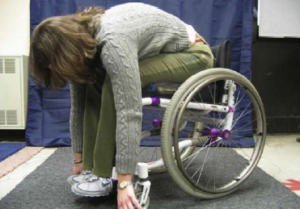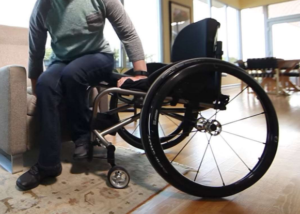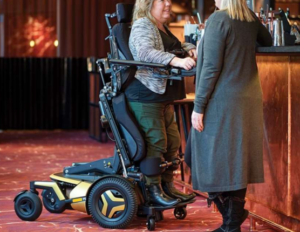Stop Pressure Ulcer Day 2022
Disabilities often have overlooked secondary effects. Mobility issues are no exception.
But just because a side-effect of disability isn’t as easily picked up on, that doesn’t stop it being important. Today, we’re going to look at the unglamorous issue of pressure ulcers.
These are a prime example of a side-effect of mobility issues which might not immediately spring to mind. As we’ll learn, it’s hugely important that others become familiar with how problematic pressure ulcers can prove.

So, what are the key things to know about pressure ulcers? Firstly, pressure injuries such as ulcers are defined as “localised damage to skin and/or underlying tissue”
A major cause of pressure ulcers is prolonged periods with little or no movement. It’s immediately clear why those with serious mobility issues are so vulnerable to them.
Pressure ulcers fall into four categories of severity and can lead to hospitalisation if allowed to worsen over time.
Pressure Ulcer Categories
Category I pressure ulcers are the least severe but carry a serious warning. With these, the skin remains intact, but has a characteristic known as non-blanchable redness. Non-blanchable redness on skin is a marking which doesn’t lose colour even when pressed on.
With Category II pressure ulcers, matters grow much more serious. This is because they are open wounds – a notorious gateway to infection. And the risk of infection can be heightened by certain mobility product choices. Let’s think about prescriptive mobility products – powerchairs are a prime example.
To the untrained eye, prescriptive cushioning options may be viewed as a matter of superficial comfort. But they aren’t. Breathability, temperature management, and how immersive a cushion is – all factor into infection risk. Comfy cushions aren’t just a “nice-to-have” on mobility products and living aids. Those same traits which enhance comfort also enhance hygiene.

A running theme here is that even so-called “visible disabilities” may have an invisible side. Sadly, on moving through pressure ulcer categories, we find ourselves facing wellbeing problems that are anything but easily missed.
Category III and IV pressure ulcers are profoundly serious concerns. They involve full-thickness skin loss as a bare minimum and represent the point where medical intervention is urgent.
Category III pressure ulcers may be the less severe of the two, but this is rather a relative term for an ulcer that can reach right down to the fat layers under the skin.
Category IV ulcers are shockingly grisly, cutting down to muscle, tendon, even bone. By this point in time, full-blown surgical intervention is inevitable.
Complicating this, a sedentary lifestyle caused by mobility issues makes Category III and IV ulcers much harder to treat.
Make Prevention a Priority
As always, prevention is better than cure. Disability doesn’t have to lead to pressure ulcers. And both mobility product users and carers can act to stop this serious co-morbidity. Choosing appropriate cushioning and similar options during a prescriptive product build is only one measure among many.
Fortunately, not all prevention measures carry the cost of high-end pressure cushions. For one, there’s the option of adjusting positioning routines. This can make a big difference because one fundamental cause of pressure ulcers is unsuitable elevation habits. Especially important to highlight are tilt-in-space wheelchairs and powerchairs, as well as riser-recliners. As regards pressure ulcers, a possible pitfall of these products is shear.
Shear in this context means the process of skin and flesh moving against a surface whilst underlying bone does not. This compression of soft tissue fuels pressure ulcer formation.

How to avoid shear and similar threats?
Being smart with reclining angles on lifestyle and mobility products is the first step in avoiding the slipping and sliding which drives shear strain. Now this might seem a very basic and straightforward idea. And for mobility product users who can relatively easily incorporate positioning variety or even pressure-relief exercises into their daily routine, it is.
But when disability comes into the equation, things are rarely so straightforward. One major risk factor for pressure ulcers in people with mobility issues is spending very extended periods of time in the same position. Naturally, it is those with the most serious mobility issues who are likely to move the least over the course of a day – the very same group of people least able to reposition themselves. This is the point at which caregiver intervention may be needed.
Lessons to be Learnt
Returning to the idea of “invisible disability” we need to be mindful of more than just physical requirements when planning out pressure ulcer prevention. Psychosocial requirements are every bit as important. Physical wellbeing can’t come at too much of a cost in mental health.
Anyone with very serious mobility issues will inevitably be significantly affected by regular repositioning throughout the day. Not just by physical disruption but also by psychological disruption. This isn’t to imply that action against pressure ulcers should be avoided altogether. The experience of a severe pressure ulcer will more than likely leave psychological scars alongside physical ones. It’s simply to flag up an additional consideration.

Reviewing the topics which we’ve touched on, one final takeaway from this piece is the importance of a holistic approach to mobility issues. First, pressure ulcers show even some of the most visible disabilities can have hard-to-spot secondary impacts. Second, properly treating pressure ulcers – a physical ailment – demands mobility product users’ psychological needs be taken into full account. Modern best practice always seeks to reflect the complex impacts of major disability, but there’s no room for complacency. This philosophy ofdrives the awareness-raising mission of Stop Pressure Ulcer Day.
Stop Pressure Ulcer Day is a global awareness-raising initiative held annually on the third Thursday of November
- Matt Stanfield for Lifestyle & Mobility